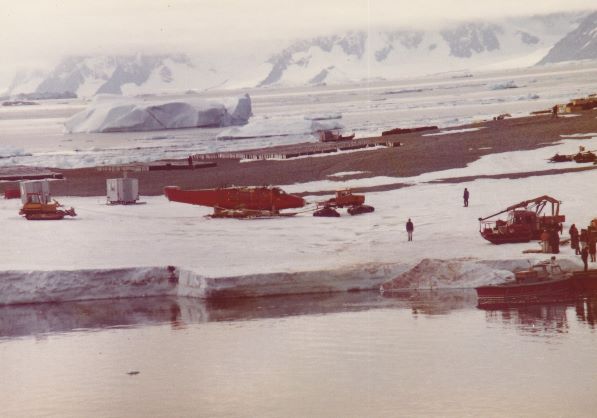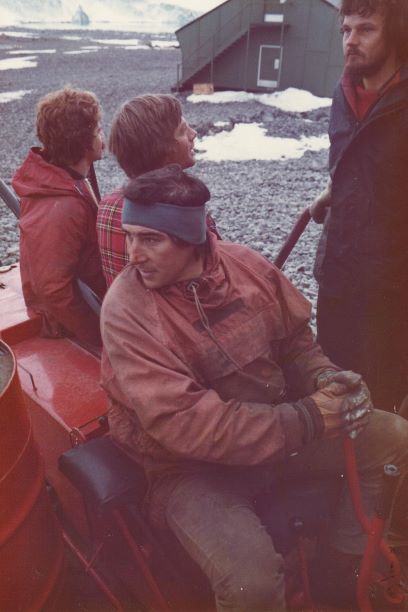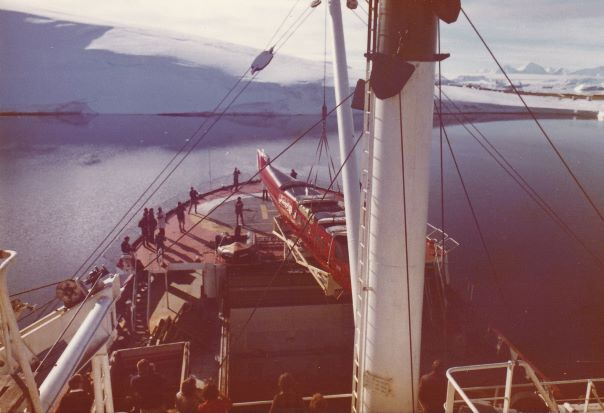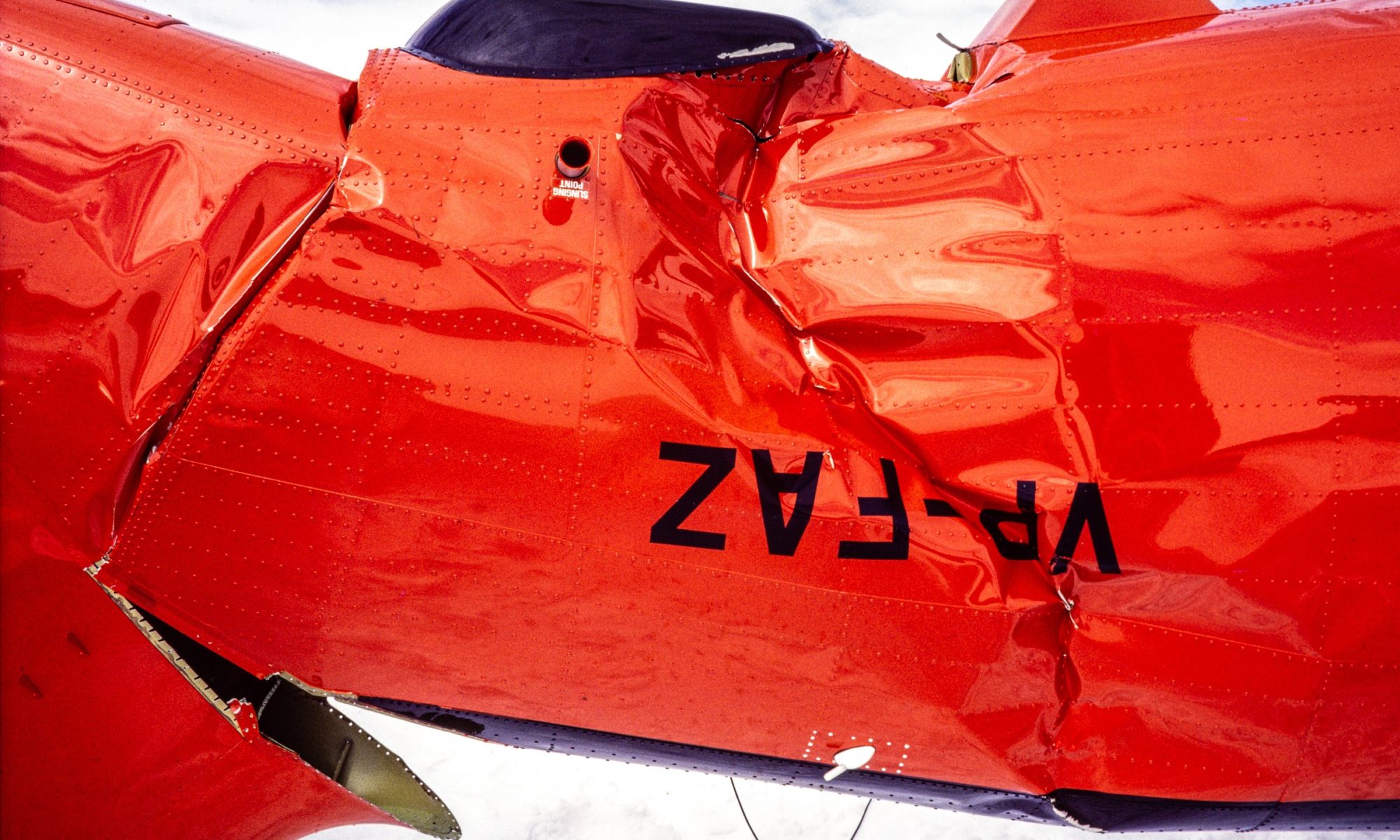Header Photo: Steve Garrett
Damage to BAS Twin Otters VP-FAW & VP-FAZ AT ROTHERA
(Extracted from BAS Report by Gary Studd, Chief Pilot – BAS Air Unit)
HISTORY
Both aircraft were last flown on 14th November 1981 , after which they were both refuelled and tethered on the tie-down points at Rothera Airstrip in accordance with the B.A.S. Air Operations Manual (2nd Edition) para 4.2; details of these tie-down arrangements are given later in this report.
From the late evening of 14th November until the time of the incident the weather prevented further flying activities from Rothera.
The airstrip was however visited at approximately 13.00 on 17th November by Dave Fletcher (Base Commander, Rothera). The wind at Rothera Base at time was approximately NE’ly at 30 knots; Fletcher however reported that the wind on the airstrip was considerably less and that the aircraft were securely tied down.
Continuing from Rothera 1981
The airstrip at Rothera is approximately 3-1/2 miles from the base complex and at approximately 900 feet above sea level (Rothera Base is 50 feet amsl). The airstrip is not visible from the Base. It is surrounded by mountains on two sides (to South and West) and local winds are known to vary in both direction and speed from those experienced at the base; the predominant direction though is from between NE and NW. Although there is a direct reading wind speed and direction indicator at the airstrip there is no anemograph so accurate observations of differences in wind velocities between the base and the airstrip, especially in bad weather when the airstrip is usually unmanned, have never been possible.
No further visits to the airstrip were made until 19th November. From midday on the 17th November the wind continued to increase on base and this coupled with extremely poor weather conditions precluded any further visits to the airstrip being made with safety. The wind at the base maintained a mean speed of approximately 50 knots for a period of several hours with peak gusts of 73 knots. It the time of peak gusts the wind backed sharply from NE to NW and was associated with a violent change in pressure tendency which had dropped to 950 mbs from which it rose 15 mbs. in the following three hours. As no wind information was available from the airstrip during this period it is impossible to say what wind velocities were experienced there, but it can be reasonably assumed that they were of a different direction and much greater strength than the winds on base. Even if information concerning the wind velocity at the airstrip had been available it is doubtful that anything further could have been done to safeguard the aircraft to a greater extent.
The aircraft have been known to weather conditions when winds of similar direction and same or greater speeds have been recorded on base with no adverse effects. On one previous occasion at Rothera one tie-down rope on one aircraft has been known to come adrift; the tie-down ropes were subsequently strengthened.
When the wind finally abated sufficiently and the weather conditions: permitted at approximately 17.00 on 19th November the airstrip was visited by Garry Studd (Chief Pilot) and Paul Gomez (Air Mech ) to check on the security of the tie-downs etc. Before even reaching the airstrip it was obvious that things were far from normal and that both aircraft were inverted, lying on their backs, and extensively buried in drift snow.
It was immediately clear that both aircraft were severely damaged certainly beyond any hope of local repair. Both aircraft were still attached to their nose tie-down ropes with the rear of the aircraft pointing in a roughly NE’ly direction. From this it can be assumed that at some time the wind direction must have been from the rear of the aircraft, i.e. between approximately SE and SW.
More than a superficial inspection of the damage was made impossible by drift snow and deteriorating weather. Extensive damage to the tail sections and rear fuselages of both aircraft was apparent and at least one wing was completely detached at the root from VP-FAW. The cockpit doors of VP-FAW had sprung open and the interior was filled with snow.
As there was nothing that could be done immediately to safeguard the aircraft from further damage, Studd and Gomez returned to the base where Studd informed Fletcher of the situation. The remainder of the base members were then informed of the disaster and a Husky signal was despatched, via R.R.S. John Biscoe, informing Cambridge of the situation. A brief sitrep was prepared for transmission to the Director early the following morning when a special radio schedule was arranged with Stanley.
The weather deteriorated within minutes of returning from the airstrip and prevented further visits until the afternoon of 20th November. Poor weather still hampered detailed investigation of the damage at this time but it was ascertained that the tail and port wing tie-down ropes on each aircraft had snapped at approximately their mid points; the nose tie-down ropes were unbroken.
The weather improved sufficiently on the 21st November for a more detailed inspection, the details of which are given in signal R/0809/81 which is included as part of this report. Drift snow and the fact that some of the more badly damaged areas (e.g. the cabin rooves) were in contact with the surface prevented a complete investigation. Avionics and similar items were removed from VP-FAW to prevent further damage from snow or water. Until a more settled outlook to the weather was predictable with some certainty a plan for dismantling etc. had been made the aircraft were left buried by drift snow as this probably provided the best protection for the aircraft at the time.
Instructions were received from Cambridge IHQ that both aircraft should be dismantled for shipment on R.R.S. Bransfield. For future reference details of this operation are contained in three separate reports. Unusually bad weather hampered operations and necessitated considerable amounts of digging out but the operation was completed without mishap or major problem by 28th December.
AIRCRAFT TIE-DOWN ARRANGEMENTS
Details of aircraft tie-down arrangements adopted by B.A.S. are given in the BAS Air Operations Operations Manual (2nd Edition). The procedures as described in para. 4.2 were in use at the time of the incident and are standard practice at all times at Rothera airstrip. These procedures call for the use of tail, wing and double nose tie-down ropes.
The tie-down ropes at Rothera had been renewed in September 1981 with brand new ropes. The tail and wing tie-downs are of 11mm (No .4) Viking hawser laid climbing rope. This rope has a snatch breaking strain of 4,300lbs under BSI specification; its actual breaking strain is reported to be realistically double this figure. The nose tie—down is of 22mm hawser laid nylon rope of undetermined breaking strain, it is however considerably stronger than the wing tie-downs.
The tie-downs at Rothera are orientated in a direction of approximately 010 Magnetic into the prevailing wind direction.
The weight of each aircraft at the time of the incident was approximately as follows : VP-FAZ – 8,300 lbs VP-FAW – 8, 800 lbs.
In addition to the tie-down ropes added security is usually obtained by the fact the after extended periods of inactivity (as in this case) the skis are frozen to the surface and buried by drift snow.
Interna1 control locks were fitted to both aircraft; FAZ with the short, new style column to panel strut and FAW with the older and longer column to panel strut. Rope prop tie-downs, normal intake blanks and canvas exhaust covers were in use at the time.
Inspection of the broken tie-down ropes (tail and port wing in each case) showed the ropes to have snapped at approximately mid-point, well clear of any knots. The steel tie-down rings had been elongated.

Down from the Airstrip 

Fid Power in Action 


(Photos: Tony Reading – Chief Officer, 1981)
METEOROLOGICAL DATA
The sudden change in pressure tendency and backing of the wind at approximately 18.00 on 18th November would appear to be the most likely time at which an equivalent change of wind velocity on the airstrip occurred.
During the period 18.00 to 19.00 the wind backed from 035 0 T to 330 0 T and during this time the maximum wind speeds were recorded at Rothera Base. It is reasonable to assume that it was at this time that the damage was sustained by the aircraft and it seems probable that during this period the wind on the airstrip must have been from the approximate direction of 200 0 T to 250 0 T and during this time the maximum wind speeds were recorded at Rothera Base. It is reasonable to assume that it was at this time that the damage was sustained by the aircraft and it seems probable that during this period the wind on the airstrip must have been from the approximate direction of 200 0 T to 250 0 T.
Historic Note

As far back as January 1975, surveyors Jonathan Walton and Graham Tourney surveyed Rothera Point, including the elevations and alignment for a hard runway (see The Start of a New Era at Rothera Point – Jonathan Walton). The following year, a section of the proposed runway was cut and graded to propose the concept to BAS. Four Twin Otters were seriously damaged on the skiway at considerable expense and loss of scientfic programs before the runway was finally constructed in the 1991/92 season, some sixteen years later, so removing the need to use the skiway.

